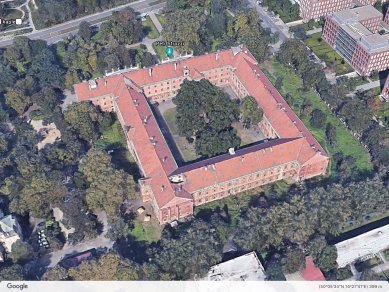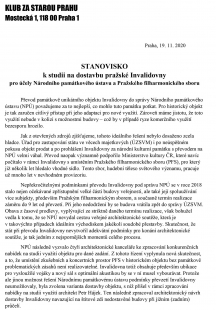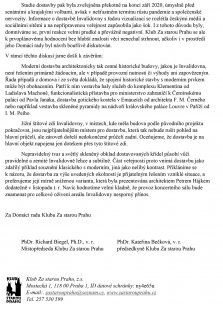
Opinion on the Study for the Completion of the Prague Invalidovna
for the purposes of the National Heritage Institute and the Prague Philharmonic Choir
Source
Klub Za starou Prahu, z.s.
Klub Za starou Prahu, z.s.
Publisher
Tisková zpráva
20.11.2020 07:00
Tisková zpráva
20.11.2020 07:00
Czech Republic
Prague
Karlín
Petr Hájek
Petr Hájek Architekti
The transfer of the monumentally unique Invalidovna to the management of the National Heritage Institute (NPÚ) is considered the best thing that could happen to this monument. This guarantees a sensitive approach to the historical object in its adaptation for new uses. At the same time, we can be assured that this use will not conflict with the building's capabilities – which would undoubtedly have been a risk in the case of purely commercial use.
As we find from open sources, this ideal solution was not achieved smoothly. The Office for the Representation of the State in Property Matters (ÚZSVM), even after an unsuccessful attempt to sell the object and after the declaration of Invalidovna as a national cultural monument with the transfer to NPÚ, hesitated significantly. Conversely, the Ministry of Culture of the Czech Republic significantly supported the transfer, additionally counting on the placement of the Prague Philharmonic Choir (PFS) within Invalidovna, for which it had been searching for a suitable residence for several years. This choir, a musical entity of global significance, has been working for many years in unsuitable temporary accommodations.
The non-negotiable conditions for the transfer of Invalidovna under the management of NPÚ in 2018 included not only the expected accessibility of a large part of the building to the public but also its shared use by multiple entities, primarily the Prague Philharmonic Choir, as well as a deadline for implementation within 9 years from the takeover. In the event of failure to meet this deadline, the building would revert back to the management of ÚZSVM. Unfortunately, the fear of a time delay arising from the strictly set implementation deadline led NPÚ to avoid a public architectural competition, which is the ideal starting point for any contemporary reconstruction in such cases. The fact that the state did not create adequate conditions for an architectural competition during the transfer of Invalidovna stands out as one of the most controversial moments of the entire process.
NPÚ subsequently invited four architectural firms to prepare competitive proposals for the use study of the building for the given assignment. From this process emerged a new fact: the placement of rehearsal and concert spaces for PFS in the historical building without heritage-problematic interventions is not feasible. Invalidovna primarily includes barracks for retired soldiers, and a new hall with optimal acoustics would need to be constructed by dismantling existing structures. However, since the conditions for NPÚ's takeover of Invalidovna did not allow for different possibilities, the option of completing the building was chosen, which was proposed by architect Petr Hájek as part of the utilization study proposal. He subsequently prepared an architectural design for the completion of Invalidovna, connecting to the gable walls of the unfinished building at the southern (rear) facade.
The completion study was then hastily published at the end of September 2020, intentionally before the Senate and regional elections, but at an unfortunate time during the rise of the pandemic and societal anxiety. Information about the completion of Invalidovna with numerous visualizations spread quickly through Czech media and social networks, and it had a shocking impact on the unprepared public. For this reason, we believe that the initial reactions were very abrupt and predominantly negative. However, the Club for Old Prague did not let itself be swept away by the simplistic evaluation without deeper knowledge of the issue, although the proposal was also discussed vigorously within its Home Council.
Through these discussions, we reached the following conclusions:
A modern completion of such an architecturally valuable historical building as Invalidovna is not primarily a desired solution, but it is not forbidden in cases of operational necessity or advantage. Many examples from home and abroad demonstrate that the combination of a historical building with modern elements can be enriching. Among them are the incorporation of a service hall into the Klementinum complex by Ladislav Machoň, the functionalist extension for the Ministry of Foreign Affairs to the Černín Palace by Pavel Janák, the completion of the Gothic church in Emauzy by architect F. M. Černý, or, for example, the insertion of a glass pyramid in the courtyard of the Louvre Royal Palace in Paris by I. M. Pei.
The southern gable walls of Invalidovna, at the points where the building was to continue according to the original project, are the most acceptable place for completion, which will not disturb the view of the main facade while also resolving the unfinished rear facade. We appreciate that the completion is only connected to the main object by a touch through these gable walls.
The irregular shape and light glass cladding of the completed wings appear light and subtle against the regular and earthy Invalidovna. Therefore, part of the public sees the completion as a successful example of harmony between the classical and the modern, while others view it as an unpleasant contrast. We lean towards the opinion that, under the aforementioned circumstances, the completion is an acceptable solution to the situation that has arisen, and we prefer its slightly reduced variant, which was presented by architect Petr Hájek additionally in November this year. Furthermore, we highly value that the operation of the concert hall will undoubtedly contribute to the overall revitalization of the Invalidovna complex.
On behalf of the Home Council of the Club for Old Prague
PhDr. Richard Biegel, Ph.D., v. r.
Vice President of the Club for Old Prague
PhDr. Kateřina Bečková, v. r.
Chairwoman of the Club for Old Prague
As we find from open sources, this ideal solution was not achieved smoothly. The Office for the Representation of the State in Property Matters (ÚZSVM), even after an unsuccessful attempt to sell the object and after the declaration of Invalidovna as a national cultural monument with the transfer to NPÚ, hesitated significantly. Conversely, the Ministry of Culture of the Czech Republic significantly supported the transfer, additionally counting on the placement of the Prague Philharmonic Choir (PFS) within Invalidovna, for which it had been searching for a suitable residence for several years. This choir, a musical entity of global significance, has been working for many years in unsuitable temporary accommodations.
The non-negotiable conditions for the transfer of Invalidovna under the management of NPÚ in 2018 included not only the expected accessibility of a large part of the building to the public but also its shared use by multiple entities, primarily the Prague Philharmonic Choir, as well as a deadline for implementation within 9 years from the takeover. In the event of failure to meet this deadline, the building would revert back to the management of ÚZSVM. Unfortunately, the fear of a time delay arising from the strictly set implementation deadline led NPÚ to avoid a public architectural competition, which is the ideal starting point for any contemporary reconstruction in such cases. The fact that the state did not create adequate conditions for an architectural competition during the transfer of Invalidovna stands out as one of the most controversial moments of the entire process.
NPÚ subsequently invited four architectural firms to prepare competitive proposals for the use study of the building for the given assignment. From this process emerged a new fact: the placement of rehearsal and concert spaces for PFS in the historical building without heritage-problematic interventions is not feasible. Invalidovna primarily includes barracks for retired soldiers, and a new hall with optimal acoustics would need to be constructed by dismantling existing structures. However, since the conditions for NPÚ's takeover of Invalidovna did not allow for different possibilities, the option of completing the building was chosen, which was proposed by architect Petr Hájek as part of the utilization study proposal. He subsequently prepared an architectural design for the completion of Invalidovna, connecting to the gable walls of the unfinished building at the southern (rear) facade.
The completion study was then hastily published at the end of September 2020, intentionally before the Senate and regional elections, but at an unfortunate time during the rise of the pandemic and societal anxiety. Information about the completion of Invalidovna with numerous visualizations spread quickly through Czech media and social networks, and it had a shocking impact on the unprepared public. For this reason, we believe that the initial reactions were very abrupt and predominantly negative. However, the Club for Old Prague did not let itself be swept away by the simplistic evaluation without deeper knowledge of the issue, although the proposal was also discussed vigorously within its Home Council.
Through these discussions, we reached the following conclusions:
A modern completion of such an architecturally valuable historical building as Invalidovna is not primarily a desired solution, but it is not forbidden in cases of operational necessity or advantage. Many examples from home and abroad demonstrate that the combination of a historical building with modern elements can be enriching. Among them are the incorporation of a service hall into the Klementinum complex by Ladislav Machoň, the functionalist extension for the Ministry of Foreign Affairs to the Černín Palace by Pavel Janák, the completion of the Gothic church in Emauzy by architect F. M. Černý, or, for example, the insertion of a glass pyramid in the courtyard of the Louvre Royal Palace in Paris by I. M. Pei.
The southern gable walls of Invalidovna, at the points where the building was to continue according to the original project, are the most acceptable place for completion, which will not disturb the view of the main facade while also resolving the unfinished rear facade. We appreciate that the completion is only connected to the main object by a touch through these gable walls.
The irregular shape and light glass cladding of the completed wings appear light and subtle against the regular and earthy Invalidovna. Therefore, part of the public sees the completion as a successful example of harmony between the classical and the modern, while others view it as an unpleasant contrast. We lean towards the opinion that, under the aforementioned circumstances, the completion is an acceptable solution to the situation that has arisen, and we prefer its slightly reduced variant, which was presented by architect Petr Hájek additionally in November this year. Furthermore, we highly value that the operation of the concert hall will undoubtedly contribute to the overall revitalization of the Invalidovna complex.
On behalf of the Home Council of the Club for Old Prague
PhDr. Richard Biegel, Ph.D., v. r.
Vice President of the Club for Old Prague
PhDr. Kateřina Bečková, v. r.
Chairwoman of the Club for Old Prague
The English translation is powered by AI tool. Switch to Czech to view the original text source.



0 comments
add comment












